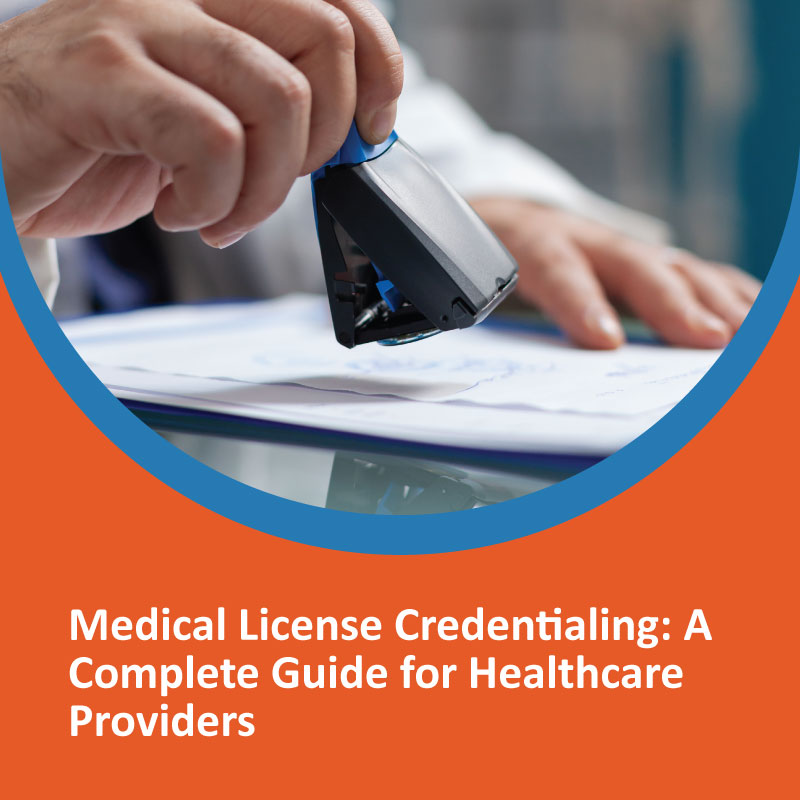Medical license credentialing is an essential process for any healthcare provider who wants to practice legally and be recognized by insurance companies and healthcare institutions. Whether you’re a doctor, nurse, or specialist, getting credentialed is the first step toward starting your professional journey.
In this guide, we’ll break down what medical license credentialing means, why it’s important, how the process works, and what documents you need. If you’re starting your medical career or opening a practice, this article will help you understand every aspect in simple words.
You may read: Medical Provider Credentialing Process
What is Medical License Credentialing?
Medical license credentialing is the process of verifying a healthcare provider’s qualifications, education, experience, training, and legal background. It ensures that the provider meets all state, federal, and institutional requirements before being allowed to treat patients or get affiliated with hospitals and insurance networks.
Credentialing is usually carried out by hospitals, clinics, insurance companies, or third-party credentialing services. The process ensures that the provider:
- Has a valid medical license
- Has completed necessary education and training
- Is board certified (if required)
- Has no legal or malpractice issues
- Meets ethical and professional standards
Why is Credentialing Important?
1. Legal Practice
Credentialing is required to legally work as a healthcare provider. Without it, you cannot treat patients or prescribe medications.
2. Insurance Reimbursement
Insurance companies, including Medicare and Medicaid, will only pay for services provided by credentialed professionals. So, without credentialing, you can’t get paid through insurance claims.
3. Hospital Privileges
If you plan to work at a hospital or healthcare facility, you’ll need hospital privileges. Credentialing is a key requirement to get these privileges.
4. Builds Trust
Credentialing proves that you’re qualified and trustworthy. Patients, employers, and institutions rely on credentialing as proof of your professionalism.
The Medical License Credentialing Process
The credentialing process can take anywhere from 30 to 180 days, depending on the state, specialty, and the organization reviewing your credentials. Here’s a step-by-step breakdown:
Step 1: Gather Required Documents
You will need the following:
- Valid state medical license
- Medical school diploma and transcripts
- Residency and fellowship certificates
- DEA certificate (if prescribing medications)
- Board certification (if applicable)
- Work history (last 5–10 years)
- Malpractice insurance details
- References or letters of recommendation
- Identification documents (e.g., driver’s license, passport)
Step 2: Submit Application
You will either fill out a credentialing application through the hospital, insurance company, or a third-party credentialing service. This form includes your personal information, qualifications, and background history.
Step 3: Primary Source Verification (PSV)
This is the most important part of the credentialing process. The credentialing team will contact medical schools, licensing boards, past employers, and other institutions to verify that all your information is accurate.
Step 4: Background Checks
Your application will go through a criminal background check, malpractice claim history check, and possibly a credit check depending on the organization.
Step 5: Final Review and Approval
Once all information is verified, a credentialing committee will review your application. If everything checks out, you’ll receive approval and be officially credentialed.
Common Challenges in Credentialing
Medical license credentialing can be time-consuming and stressful. Here are some common hurdles:
- Missing or outdated documents
- Delays in primary source responses
- Unclear work history or gaps in employment
- Issues with board certification status
- Past legal or disciplinary actions
To avoid delays, keep your records updated and respond quickly to requests from credentialing organizations.
How to Speed Up the Credentialing Process
- Start early – Begin at least 90 days before your desired start date.
- Stay organized – Keep a digital folder with all required documents.
- Use credentialing services – They can handle everything for you.
- Follow up regularly – Don’t wait too long if you haven’t heard back.
Re-Credentialing and Maintenance
Credentialing is not a one-time process. Most healthcare facilities and insurance companies require re-credentialing every 2 to 3 years. This ensures that your qualifications, licenses, and malpractice history remain up to date.
Make sure to:
- Renew your medical license on time
- Maintain malpractice insurance
- Stay current with continuing medical education (CME)
- Keep your work history updated
Final Thoughts
Medical license credentialing is a necessary and important part of any healthcare provider’s career. While it can take time, the process protects both patients and professionals by ensuring high-quality care and legal compliance. By understanding what’s required and preparing your documents ahead of time, you can avoid delays and start practicing with confidence.
Whether you’re a newly graduated physician or an experienced provider switching jobs, never underestimate the importance of being credentialed properly. It’s the foundation of your professional reputation and the key to a smooth practice in the medical field.
FAQs About Medical License Credentialing
1. How long does medical license credentialing take?
It usually takes 90 to 180 days, depending on the complexity of the application and response times from verifying institutions.
2. Can I start practicing before being credentialed?
No, you must complete the credentialing process before legally practicing or billing insurance.
3. What happens if my credentialing is denied?
You may be given a chance to correct errors. In serious cases, denial may limit your ability to work or bill insurance.
4. Do I need to be credentialed with each insurance company?
Yes, every insurance provider has its own credentialing process, and you need to apply to each one separately.
5. What is the difference between licensing and credentialing?
Licensing is done by the state to allow you to practice. Credentialing verifies your qualifications for employers and insurance companies.


